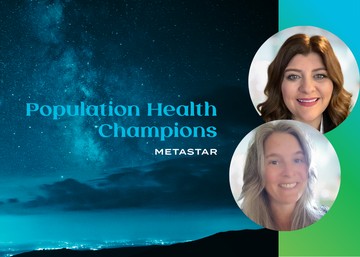

Population health strategies unlock opportunities to drive better health outcomes by working beyond the walls of clinical care. Health systems adopting population health approaches are working tirelessly to prevent diseases by aligning teams across departments and functions. But that’s just one piece of a much bigger picture.
Real population health success lives at the intersection of health care and public health. It must include community groups, coalitions, public health partners and payers to build programs that go beyond clinical care. It requires coordination, trust and sustained effort — things that are difficult to maintain in addition to daily operations, staffing pressures and evolving metrics.
Healthcare quality improvement organizations play a critical role in fostering this collaboration and have a unique vantage point on how to be successful. We recently spoke with two leaders from MetaStar, a Wisconsin-based healthcare quality improvement organization, who are working to bridge the gap between health systems and public health. Emily Nelson, Vice President of Healthcare Transformation and Jill Hanson, Project Specialist, Healthcare Transformation from MetaStar shared how meaningful collaboration, mutual respect and sustainable actions are moving the needle for Wisconsin health and healthcare.
“Not involving the right people in the coalition at the right time will lead to failure.”Jill Hanson - Project Specialist, Healthcare Transformation, MetaStar
Invest in people and relationships
According to Emily and Jill, successful population health initiatives require investments in dollars, data and reporting, but more importantly, a deep investment in people and relationships. Staffing shortages and other priorities often pull collaborators in multiple directions, but creating intentional time and space for community connection can make a real difference.
Jill noted, “Where we've seen struggles getting organizations to the table, it's because they have other competing factors like staffing issues. They can't take the time to be part of this collective even though they recognize the importance of it.” She also highlighted that, “Not involving the right people in the coalition at the right time will lead to failure.”
Emily believes the best results come from bringing the right people together from the start. A great example is a recent proposal developed for the Agency for Healthcare Research and Quality, focused on excessive drinking in Wisconsin, which convened a large group of different stakeholders to come together and work on the topic. Emily shared “The fact that we are able to get buy-in from Medicaid, from payers and people with lived experience to work on this is a big, big, big challenge. I'm pretty proud of that.”
Mutual respect is critical above all else. Emily says that “Respect across the board is really important, as is a drive to understand each other … In terms of the services they provide and the challenges they face.”
Empower a quarterback to lead the collective
It’s hard to avoid a sports analogy on the topic of teamwork. But much like football, the most successful population health initiatives have a quarterback serving as the backbone for the team. While the team works toward a shared goal, the quarterback calls the strategies and helps set up the plays. MetaStar does just that, bringing clarity, keeping momentum high and ensuring everyone stays aligned and accountable.
Jill explained, “It's a challenge for [partners] to understand how to collectively come together. That's where [MetaStar] allows them to create this wonderful collaboration within their community.” Emily added that, “We keep things moving, organized and action-oriented.”
For health systems and coalitions that struggle to collaborate and make forward progress, a quarterback role that understands the processes, goals and language unique to each of the partners can turn fragmented efforts into real, sustained impact.
Emphasize shared goals over individual priorities
Real impact is only possible when collaborators can check agendas and competing priorities at the door. Jill shared a successful example where a community coalition set that as their expectation.
"Any competition that we have is going to sit at the doorway when you come in, and we are going to be as transparent as we can, and as open and psychologically safe as we can be in this meeting space.” That allowed them to really identify the strengths and barriers and brainstorm their focus as a collective. “What are the things that we can control as a collective, and what are some things that we can do within our home organizations to support this work?” shared Jill.
It’s a powerful example of what can happen when collaboration is driven by purpose — not position.
Democratize data and make progress measurable
One of MetaStar’s most practical tools is the Results-Based Accountability (RBA) framework, which asks:
- How much did we do?
- How well did we do it?
- Is anyone better off?
“We try to keep those answers front and center throughout the work,” said Emily. These simple, clear questions help coalitions maintain focus and evaluate impact — a valuable insight for health systems seeking to demonstrate ROI in population health programming. When everyone at the table has a clear vision of success, it’s easier to move forward together.
Measuring progress is a common hurdle. One of the most persistent challenges is that the data most needed for community health efforts is often deprioritized within health systems. “They may have other, bigger fish to fry … And if you want to track things like advance directives, it’s not always top priority. What's on their data dashboard may not be relevant ... And they have to evaluate ‘is our IT dedication to this worthwhile?'” said Jill.
These gaps in prioritization can create major hurdles for community coalitions trying to make informed decisions. And when data is siloed within health systems it can stall progress and disrupts the collaboration. Health systems can support a democratization of data by elevating community-relevant metrics alongside operational ones, sharing insights regularly with coalition partners and involving non-clinical voices in deciding what matters most.
Sustainability is critical, and it starts with skills transfer
For health systems and community coalitions to truly build healthier communities together, they must focus on building sustainable solutions. MetaStar focuses on building capacity within communities so they can eventually lead and maintain their own initiatives.
“We're looking in terms of sustainability,” said Jill. “How does that community then develop the skill set to be able to lead this?”
For health systems, this means supporting leadership development among community organizations, ensuring that progress continues even after grants end or priorities shift.
Lived experiences should guide your program design
MetaStar intentionally brings individuals with direct experience into coalition planning from the beginning. “If we're going to set up a coalition ... We’re going to bring folks that have lived that experience to the table at the very beginning to help us use co-design methodology or human-centered design methods to build that coalition from the ground up,” said Emily.
By including people who have firsthand experiences from the beginning, coalitions gain more accurate insights into community needs, create more relevant and sustainable solutions and build stronger ownership among participants. Emily shared that this approach “has really been a shift in the last couple years … And has been a beautiful thing to see in so many ways.”
Emily’s and Jill’s advice to other population health champions
Jill’s advice for other population health leaders is simple but impactful: “Have conversations, and be open to hearing the good, the bad and the ugly.”
Emily stressed the importance of having a clear charter: “Get the scope documented as best as you can. What’s in scope? What's out of scope? What are the measures of success? How are we tracking that from the very beginning? If that's not part of the infrastructure from the beginning, it just won't work.”
Closing thoughts
Real progress in population health depends on connection, collaboration and shared vision. Impact isn’t just about the initiatives themselves, but by how health systems and community partners show up together.
MetaStar’s approach demonstrates that showing up means more than sponsoring a meeting or funding a program. It means investing in relationships, committing to shared goals, empowering community voices and being willing to collaborate on community terms, not individual priorities.
For health systems ready to lead, the opportunity is clear: step into the messy middle and help build the bridge between healthcare and public health. The messy middle is where collaborators can create the conditions for better health — not as an aspiration, but as an achievable, shared reality.
Recommended reads and hobbies
Jill is currently reading A Winter’s Promise, a four-part series by Christelle Dabos. Amazingly enough, she reads it on her tablet while knitting. (Now that’s a masterclass in multitasking!)
Emily currently dedicates her spare time to raising pigs with her kids, who show the animals at livestock fairs — and is loving every minute of it.


